Abstract
Design thinking as a mindset and as a process for design and business innovation receives a lot of attention. Thus, concrete and structured methods for design thinking need to be devised, and design thinking competencies should be fostered proactively. Design thinking is underpinned by visual thinking composed of interactive iterations of Seeing—Imagining—Drawing. The visual reasoning model developed to understand and support visual thinking describes the process with cognitive activities as well as knowledge and schema. The visual reasoning model could serve as a framework to devise structured methods and tools for design thinking and to foster design thinking competencies. It would be desirable if schema to serve as underlying models in imagining service activities are to be identified so that cognitive activities in seeing—imagining—drawing can be systematically structured in service design, where the objects of designing are human activities and experiences. In this paper, three structured design methods developed for service design have been described and characterized in the framework of the visual reasoning model. Particularly the context-based activity modeling has been demonstrated as schema in structured imagining of service activities for product-service systems, as it serves the underlying role in organizing information on human activities consistently and yet with different interactions with other constituents of these three imagining methods.
1. Introduction
Design Thinking has received a lot of attention as a problem-solving method applicable in business innovation and diverse complex problem-solving tasks, as well as in design [1,2,3]. The design thinking process is composed of the sequences of Empathize—Define—Ideate—Prototype—Test [4]. Additionally, recent merges of design consultancies by large innovation firms reflect interests in design thinking in the business industry.
Design thinking is abductive [2,5] entailing imagining what might be, and is composed of divergent and convergent phases [6]. Design thinking can deal with problems in many different fields, as the generative cognitive process is generic, not dependent on any specific field [7]. It is user-focused, involving users and diverse stakeholders as well as problem solvers [8]. Design thinking demands imagination and abstraction capabilities [7]. It also requires flexibility and tolerance for ambiguity, echoing basic cognitive and affective factors needed in creative learning [9]. Design thinking leverages creativity as a driver of innovation and intensively uses prototyping as a rapid and effective enabler of innovation development [10].
Design methods would bring systematic and rational procedures in design processes [11]. Typical features of design methods are formalizations of certain procedures and externalization of design thinking [11]. It is desired to devise concrete methods and tools for design thinking. By understanding mindsets and tactics founding designerly ways of thinking, efforts can be made to help problem solvers in both design and non-design fields exercise successful design thinking. Devising structured design methods would make clear contributions.
Recently, visual thinking [12] has been explained as an underlying framework for design thinking [13]. McKim described visual thinking as interactive iterations of Seeing—Imagining—Drawing [12]. The process would start from seeing as the basic perceived understanding of the problem. Next the process moves to imagining, where potential solutions are newly imagined. While many aspects of these solutions are still ambiguous, designers imagine these initial potential solutions in their minds. Then they move to express the imagination by drawing. Looking at the sketch, designers check whether the sketched imagination could be a solution to the problem understood with the previous seeing processes. By seeing that, the improvements needed are identified. Imagining and drawing of solution improvements follow. Through seeing, understanding of the problem may be reinterpreted, then further imagining comes again. Simple prototypes substitute drawings at some stages. Designers see these simple prototypes themselves. Imagining continues with further changes. Next, improved prototypes with some partial functions are made. The next seeing process may involve potential users for their feedback so that imagining of improved solutions can continue.
Design thinking has been described in the framework of visual thinking [13], as shown in Figure 1. The Empathize process begins design thinking as a part of Seeing. In Seeing, pain points and delight points with negative and positive values are identified. Seeing also includes a determination of target values and the scopes of problems. Problem defining would require many iterations of partial solution generation and problem interpretation as problems and solutions co-evolve [14]. Define corresponds to the overlap of Seeing and Imagining. The Ideate process of design thinking is the Imagining of visual thinking. Imagining would mean that even vague and premature ideas can be imagined, as these will be improved through the next iterations with Drawing and Seeing. New customer experience activities need to be generated, but also existing activities can be transformed. Imagining is evoked by the results of Seeing. Imagining also builds upon what’s been imagined in previous iterations of Seeing—Imagining—Drawing. Ideate is Imagining interacting with Seeing and Drawing. The Prototype process corresponds to Drawing in visual thinking, and Test belongs to Seeing. Note that the Test process is a part of the next iteration. That is, the visual thinking process is inherently iterative. Test may involve evaluations of potential customers. Note that evaluation criteria are those value themes identified in the Empathize process. In this way, the Test process is at the intersection part of Drawing and Seeing. The perspective of design thinking in the framework of visual thinking would make contributions in understanding design thinking both [15] as a descriptive model of the design process and as a prescriptive method of design and business innovation.
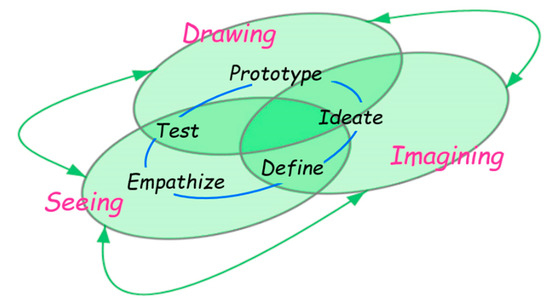
Figure 1.
Design Thinking in the framework of Visual Thinking [13].
A visual reasoning model was developed to understand the cognitive process by describing the visual thinking process of Seeing—Imagining—Drawing with basic cognitive activities [16], as shown in Figure 2. Various visual reasoning abilities were observed and explained using the visual reasoning model [17]. Relationships between design creativity and the sketching process were studied using the visual reasoning model as an analysis tool to evaluate cognitive activities and creativity in design [18]. The visual reasoning model is now briefly reviewed. In the Seeing process, perception, analysis, and interpretation occur. The Imagining process enables us to synthesize using perceptual and conceptual information for new representation. The Imagining process has been classified as generation, transformation and maintenance slightly modifying [19]. Generation and transformation were proven to be critical in the creative design process [20]. Image maintenance occurs to keep the internal representation of generation and transformation. The Drawing process enables representation internally and/or externally. This process occurs in interaction with the Imagining and Seeing processes. In addition, knowledge and schema are engaged in interaction with the visual reasoning process. Schon suggested that empirical knowledge affects the iterative process of framing, moving, and reflection [21]. That is, retrieval of knowledge becomes a cue for perception in the Seeing process. By schema, information can be reorganized in the iteration process of Seeing and Imagining [22]. Visual reasoning is a linking process between perceptual and conceptual knowledge [23].
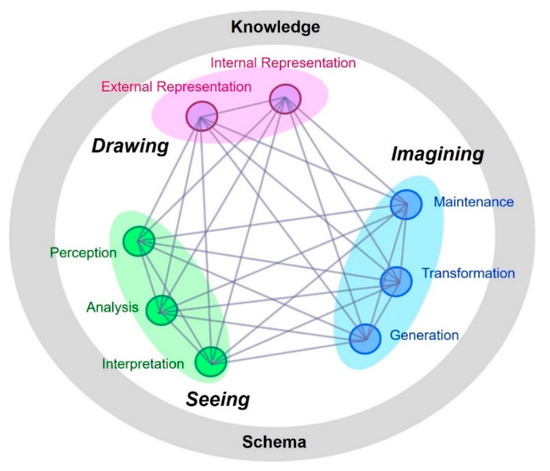
Figure 2.
Visual reasoning model [16].
The visual reasoning model was also used in analyzing the design processes of expert designers. It was noted through retrospective interviews with designers and protocol analysis data that more active interactions among the basic cognitive activities were observed when creativity leaps happened compared to other parts of design processes [16]. Note that the reasoning process, composed of iterations of interpretation, hypothesized imagining, representation, and evaluation analysis, as depicted using the visual reasoning model, is equivalently described by design reasoning composed of formulating, moving, representing, and evaluating as Lawson and Dorst described design activities [24]. Note that the order of moving and representing above follows that in visual thinking as representing is made based on what has been imagined while they occur almost simultaneously. The visual reasoning model is now receiving attention in research as an underlying cognitive model for design [25,26].
This paper addresses one of the key constituents of the visual reasoning model, schema, in structured design methods. Schema support organization of information in design reasoning. Such schema should support generation and transformation, allow representation, or accommodate perception, analysis, and interpretation. The objective of this research is to demonstrate the context-based activity modeling (CBAM) of activities [27] as schema for systematic imagining methods for service design. Multiple specific imagining methods are characterized regarding how the schema is used with other key constituents of the methods by the visual reasoning model [16] developed to understand and support visual thinking.
The paper reviews CBAM as a formal structured modeling of human activities in the next section. Then, systematic imagining methods using CBAM are described in the subsequent sections. First, the structured What If? method is explained together with an application design case for the sustainability of clothes. The characteristics of the structured What If? regarding how the schema is used is explained. Next, the systematic service activity design method using the hierarchical mapping of values and activities is described. How the schema is used in knowledge representation and in analogical reasoning and interacting with another schema of hierarchical value map is discussed. Then, the personalized customization service design method using accumulated experience evaluations is described, as well as its characteristics from the visual reasoning perspective. Potential contribution of the schema in devising the notion of sustainability features for design for circular economy and in development of integrated product and service lifecycle management is discussed in the last section.
2. Service Design and Context-Based Activity Modeling
Service design thinking combines the mindset and methods of design thinking together with embodiment strategies for creation of new services and customer experiences based on the perspectives of service dominant logic [28] and experience economy [29]. Services are defined as activities of service providers conducted for service receivers [30]. An activity is composed of actors, action verb, objects, tools, and contexts as described below in detail. Thus, the designing of activities encompasses the designing of these activity elements. Overall methods of designing services in the relatively early phase of the service design field have been reviewed in [31]. Design for services incorporates broader views on service design that value relations between diverse actors are dynamically co-created in socio-material and human-technical systems [32]. Whether service design is viewed as designing services or design for service, human activities and experiences are at the core of designing. Note that contexts are critical in understanding and designing activities and experiences [33]. Hierarchical views on value network, service architecture, and low-level activities and experiences were introduced [34], and a detailed representation of the resulting service design utilized service blueprints and various extensions [35,36,37,38]. The methods and tools for the ideation phase in service design include brainstorming, mind-map, What If? and design scenario [39], which are usually not as structured.
The service design method composed of the following four major phases: (1) Value modeling, (2) service activity design, (3) service interaction design, and (4) experience evaluation and management, has been proposed by Kim [40]. Here, identifying diverse values including economical, ecological, and experience values is essential [41]. The activities of service receivers and providers, as well as other stakeholders, are designed. Service interactions are designed with a lot of cares on touchpoints. Then, stakeholder experiences are to be assessed and managed to close the loop so that the designing of services can be evolutionally developed. This service design process has been developed and utilized as the core process of product-service systems (PSS) design [38]. Note that a PSS is a combined system of products and services as well as infrastructures, interrelations, and data with which stakeholders, including customers and product/service providers, co-create values [42,43,44]. Since the early development efforts of PSS, providing ecological values has been the primary intention [42,43], and PSSs are commonly understood as effective instruments to realize circular economy [45,46].
Context-Based Activity Modeling
This section reviews the Context-Based Activity Modeling (CBAM) [27] to describe activities in detail. Its schematic diagram is given in Figure 3. The activity description is centered around the action verb. The object of the action is specified as the object element of the activity. The active actor is the subject stakeholder of the activity who performs the action. In some cases, the passive actor and/or the third-party actor are specified as well. The tool of the activity is specified when a tool is used in the action. Another element of the activity in CBAM is the context, which is in turn described by the following four context elements: The goal context, the relevant structures, the physical context, and the psychological context. The relevant structures are the entities associated with the object element in the action. The physical contexts such as location and time are specified. The psychological context such as emotional states and motivation level can be associated. In addition, whether the activity is public or private, and whether the activity is performed alone or with others can be specified as social context as a part of the psychological context. Through this rich description of activities as an underlying mechanism, diverse experience issues can be addressed in human activity-centered experience design. That is, CBAM is regarded as a basic underlying schema in service activity design. Those activities in service blueprints [35] are represented in detail using the CBAM method [38].
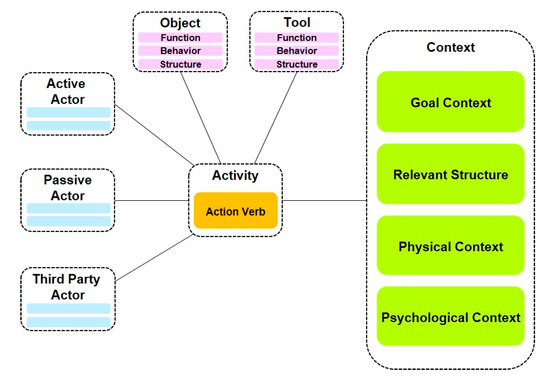
Figure 3.
Context-based activity modeling (slightly modified from [27]).
CBAM has been used in a systematic method of design for affordances using analogical reasoning [47]. Affordance features are structural elements of artifacts that provide affordances, which are messages artifacts give so that human activities are naturally induced if the messages are properly perceived by the users. CBAM is used to describe the activities afforded by relevant affordance features. Specific affordance features in the repository also contain specific information on these activity elements and context elements. Note that this information is critical in devising target affordance features through analogical reasoning. This has been used in designing the product-elements of PSSs once service activities are designed [40] and in redesigning products considering specific service activities in their life cycle steps [48].
3. Structured What If? Method using Context-Based Activity Modeling
In the Ideate phase of design thinking, a lot of ideas for potential solutions are generated in a divergent manner. Fluency is one of most important cognitive elements for creativity [9]. What If? is a method to generate ideas [3,39]. It would be desired if this What If? method can be systematically structured for service activity design. CBAM serves as the schema for What If? Ideation, as explained below.
3.1. Structured What If? Method
In the Empathize and the Define phases of design thinking, the pain points of user experiences are perceived. Analyzing the activities at those pain points, potential solutions to overcome those pain points are sought in designing for services. If those activities are modeled in detail using CBAM, each activity element and context element of each activity in pain points can be systematically visited one by one for the What If? hypothesis.
For example, if an activity at a pain point does not have any tools activity elements, ‘What if that a tool is newly introduced to the activity’ can be hypothesized. If a tool is used currently, ‘What if a different tool is used?’ can be considered. A simple example would be the idea of self-service, which changes the active actor of service activities from the service provider to the service receiver. The context is composed of context elements. For each context element, ‘What If? that the current context element is to be changed’ could be tried. In this way, “What If?” could be systematically structured using the CBAM method as schema.
3.2. Case: Used Clothes TakeIN Product-Service System Design
The case of used clothes, the TakeIN product-service system design can demonstrate the utility of the structured What If? method with the schema of CBAM. TakeIN is the name of the sustainability PSS series for the efforts to develop PSSs that enable sustainable reuse of products, indicating taking them back in use rather than throwing them away.
3.2.1. Transformation of Service Activities Using CBAM
The current experience of used clothes reuse is well described by the journey map of donated used clothes shown in Figure 4. A donator user brings used clothes to a nearby collection bin, and gives used clothes using the collection bin as a tool. Then, those used clothes inserted in the collection bin are collected in bulks by a service provider as if they were trash. Some useful clothes are selected and sorted by laborious efforts of human service providers. Those used clothes that have gone through this journey are delivered to receivers who would wear them. This overall service process is represented in the as-is service blueprint. A simplified version of the service blueprint is shown in Figure 5. Note that this kind of service experience of used clothes donation dictates the major aspects of used clothes reuse culture. Such reuse culture gives significant influence on clothes use culture and practice as well.
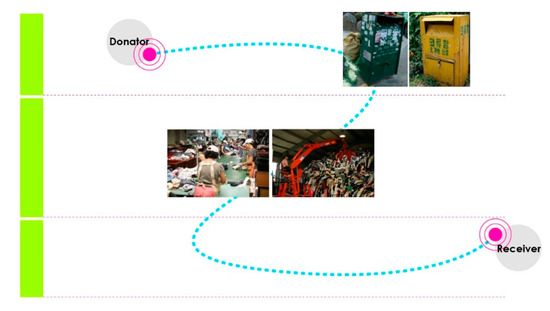
Figure 4.
Journey map of donated used clothes.
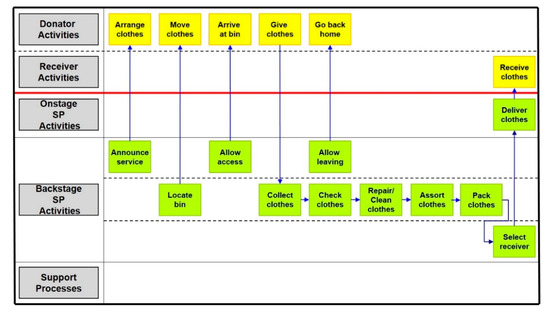
Figure 5.
As-is service blueprint of used clothes donation.
A key activity in the journey is the donator’s activity of giving used clothes with the tool of the collection bin. The activity and relevant experiences can be varied a lot depending on the contexts. Now suppose that a housewife would have to donate used clothes at night on a rainy day. As most collection bins are located in back alleys, the activity of giving used clothes using the bin in such a physical context would make for an emotionally unfavorable experience. She would feel unsecure in doing the giving activity alone in the occupant context that nobody else is around and feel uncomfortable due to dirty surroundings. She would have to be hurried if she did. Overall, she would be very reluctant. She would not like to do that at all. This is represented in detail in the CBAM description in Figure 6. If her husband were around, her solution would have been to have him do the activity. In general, this particular activity would be a pain point for many donators.
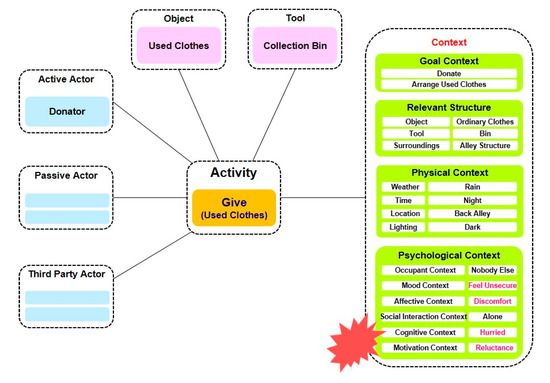
Figure 6.
CBAM (context-based activity modeling) description of as-is activity of giving used clothes.
To transform this activity to the positive side is to use What If? Systematically, going over the activity elements and context elements of CBAM description of the activity. While actor, object, and tool elements are not easy to change, some physical contexts can be altered. Changing the weather and the time may not be a proper option to ensure good applicability of this activity regardless of time and weather constraints. The location context might be changed. What if the location is changed from the back alley? What if the location is changed to a community center? Would it be accessible enough? What if the location is changed to a convenience store? In many cities, accessibility of convenience stores is good. They are close enough and open for long hours, often 24 h a day, 7 days a week. Now it is good for donators. Other stakeholders should be considered as well. For the collectors, all convenience stores are accessible with trucks to load and unload stuff. In this way, the What If? hypothesized solution is evaluated for suitability. The to-be activity of giving used clothes as transformed by the What If? method is shown in Figure 7. The relevant structures would be changed also. Note that the physical context of lighting has been transformed from dark to light together with the location context change. Psychological contexts have also been transformed positively, and the pain point is now overcome.
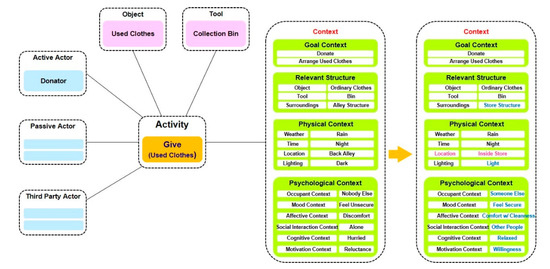
Figure 7.
CBAM description of to-be activity of giving used clothes transformed by What If?
Structured What If? can be conducted further. Activities currently performed by service providers can be analyzed from What If? perspectives. In the current service, used clothes are delivered to receivers in whatever packed state. The activity of packing used clothes is currently performed by service providers. What if the active actor of this activity is changed? What if the donator becomes the active actor of the packing activity? In this case, the donator is giving not only used clothes, but also his effort of packing. If you consider the situation where you give the used clothes of your baby to a niece as your baby gets older, you would clean the used clothes, fix buttons properly, and pack it neatly as if you pack a gift. Even though a donator is giving used clothes to someone she does not know, she can experience bigger active emotional values of achievement and pride that she is doing good as she packs used clothes herself. She would also clean and repair the clothes before packing so that those positive active emotional values can even be enhanced. The result of these What If? scenarios is shown in the to-be service blueprint in Figure 8. This imagining is enabled by the structured What If? that the active actors of activities would be changed.
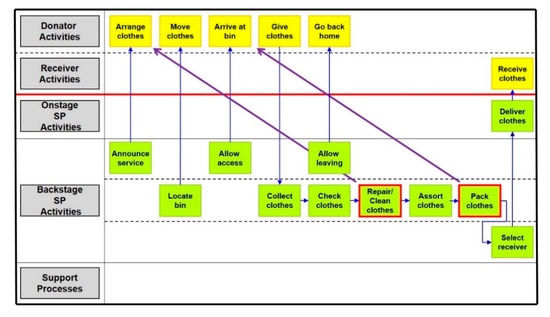
Figure 8.
Transformation of packing and Repair/clean activities by What If? method.
3.2.2. Transformation of Clothes Reuse Culture and Clothes Consumption Practices
Note that a lot of activities in the used clothes reuse service have been performed by the donator so that all the remaining downstream operations can be done in such a nice manner. The to-be journey map of used clothes TakeIN PSS is shown in Figure 9. The packages containing information about the donated clothes are readily collected by collecting service providers. Used clothes are stored nicely in those packages. Selecting appropriate receivers is done easily, as information on used clothes is stored for all donated clothes. Receivers would be very grateful to donators for their giving of warm and used clothes. The journey of donated clothes in this new material-social system is totally different from the as-is case. Experience values of many stakeholders involved could be much improved.
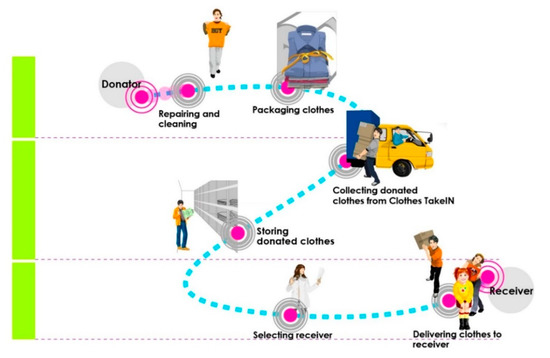
Figure 9.
Journey map of to-be used clothes TakeIN product-service system (PSS).
For this used clothes TakeIN PSS, a new collection bin, or TakeIN station, needs to be designed so that donator’s activities of information giving, packing, and inserting used clothes into the TakeIN collection unit can be smoothly and naturally induced and supported, as well as other stakeholders’ activities. The location of inside convenience stores improves much of the experiences of donators. However, it would also increase costs in operating the PSS. Certainly, the business model issues should also be incorporated in the used clothes TakeIN PSS. Though discussions on the business model issues are outside of the scope of the current paper, it is noted that the What If? method using CBAM can be used here again. What kind of values exchanges would be related to the business model issues in the case where the location is inside convenience stores? What if the location context is changed to other locations? What if the TakeIN station is located inside an outlet of a clothing brand? What if it is located in a shopping mall?
The service concept presented in the journey map of Figure 9, where donators take up many activities as an active actor, would need to handle a lot of issues including design of new physical touchpoints and design of a sustainable business model. However, behavior changes in the activity of giving used clothes as if they were given as presents could contribute not only to the donation service, but also to clothes reuse culture. Even though the ownership of used clothes and their use context are to be changed, reuse life of the used clothes can be better supported by transferring functions and structures of the clothes in decent ways. It would be desirable if donator’s experiences of using the clothes including information on the used clothes can be transferred together with physical material aspects of used clothes with efforts by the current user. In this way, the used clothes TakeIN PSS can contribute to the transformation of clothes reuse culture and clothes consumption practices. Note that the design for sustainability methods has evolved from the product innovation level to the product-service system innovation level, then to the socio-technical system innovation level [49]. The design for sustainable behavior efforts emphasized more of the consumer activities and behavior [50]. The evolution of the used clothes TakeIN PSS would develop as discussed above goes in parallel with the trend in design for sustainability and circular economy. This issue will be discussed further in the conclusion section of the paper.
3.3. Characterization of the Structured What If? Method Using CBAM
The structured What If? method using CBAM is now characterized based on the visual reasoning model. Eight basic cognitive activities and schema are interacting in the iterations of Seeing—Imagining—Drawing. In the outer iteration of Seeing—Imagining—Drawing, pain points are identified based on perception of users and the interpreted problem to overcome pain points is formulated. The What If? method is used to ideate potential solutions. The method is to support Imagining.
Activities at pain points are represented using the schema of CBAM. Based on analysis of activities at pain points, structured What If? transformations are hypothesized for each activity element and each context element of CBAM description of the activities. In this way, the CBAM schema allows systematic imagining of new activities. Here, transformation of activities at pain points using the schema of CBAM is the specific method for imagining new services.
4. Structured Analogical Reasoning Using a Hierarchical Value Map
Analogical reasoning [51] is a general method for ideation, such that the solution ideas of previous design cases are used to devise solution ideas for the present design problem. The structured imagining method using a hierarchical value map (HVM) is composed of two stages: The first stage of constructing knowledge of HVMs, and the second stage of using HVMs of previous service design cases to imagine activities to realize value themes of a new service design case by structured analogical reasoning [52].
4.1. Structured Service Imagining Using a Hierarchical Value Map
Service design seeks to realize values by designing human activities and experiences. The analogical reasoning approach to exploit knowledge of previous service design cases is structured with schemas of HVM and CBAM in this method. The structured method is briefly reviewed below.
4.1.1. Hierarchical Value Map
Relations of values and their realizing activities are described by a HVM with value themes, drivers and attribute activities. Value drivers have both instrumental and responding roles linking value themes and activities. Drivers may refer to instrumental values, while value themes are terminal values. An attribute activity is an activity that evokes a driver. By finding drivers accruing negative/positive valence and linking them to activities and their elements, the mapping from a value theme to activities is completed. For example, the terminal value Fun in the case of shopping mall service design is linked to the activity of looking at a mirror through the positive driver of looking good. In the case of a blood donation center, value Fun has positive driver Together, which is linked to activities to wait and to have a conversation. Note that this HVM is a concrete means-end chain [53] developed for service activity design.
4.1.2. Structured Analogical Reasoning
In the first stage of value modeling, various instrumental values are identified based on users’ perception of their experiences of activities in the current journey. These user perceptions are then analyzed by the design team to come up with terminal experience value themes. HVM is the schema in value modeling. Current activities are described based on the schema of CBAM as describe above. Problem interpretation is formulated with pain points and delight points identified. The value modeling stage is based on two schemas of CBAM and HVM.
In the second stage of imagining new service activities, for each target value theme, activities to realize the value are imagined systematically in the following steps. HVMs of the value, the knowledge stored based on the schema of HVM, are retrieved. For each activity in the retrieved HVM, transformations of the activity into a target activity are hypothesized, represented, and evaluated based on the schema of CBAM addressing activity elements and context elements systematically. Note that this step corresponds to inner iterations of imagining, drawing and seeing. For example, in the new task of Café service design, the new activity to have a conversation has been imagined by analogical reasoning of the source activity to have a conversation in the blood donation center case by using value driver Together in HVM and by visiting relevant activity elements and context elements of CBAM. CBAM descriptions of source and target activities are shown in Figure 10.
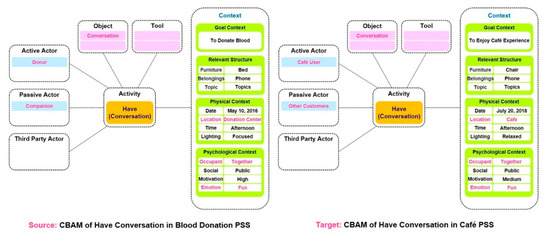
Figure 10.
CBAM of Source and Target Activities in analogical reasoning of ‘to have a conversation’ activity using a hierarchical value map (HVM) of the value theme Fun with the driver Together [52].
4.2. Characterization of Structured Service Imagining Using a Hierarchical Value Map
The service activity design method using an HVM is now characterized based on the visual reasoning model. Eight basic cognitive activities and knowledge and schema are interacting in the iterations of Seeing—Imagining—Drawing. First of all, this method is a structured ideation method. That is, Imagining is systematically supported. Imagining is supported by building knowledge on relations of values and activities using the specific schema of an HVM in the value modeling stage. This stage involves Seeing with user perception, as well as the design team’s analysis and interpretation.
In Imagining, hypothesized transformations are made, represented, and evaluated, resulting in inner iteration of imagining—drawing—seeing using CBAM as an underlying schema in describing, mapping, and adapting steps in the analogical reasoning of activities. It is typical in design thinking that inner iterations of seeing—imagining—drawing occur many times to select a feasible and desirable solution within outer iterations of Empathize—Define—Ideate—Prototype—Test.
5. Personalized Customization Service Design Using Experience Evaluation
A very systematic customization service design method has been devised so that personalized needs and contexts are supported [54]. Noting that the service design process includes value modeling, service activity design, interaction and touchpoint design, and experience evaluation and management [40], this structured method addresses all these steps evolutionarily. The customization service is led by users in a highly co-creative manner, as user experience evaluation is a key enabler for the service.
5.1. Structured Personalized Customization Service Design
5.1.1. Context-Specific Experience Sampling and Analysis
Context-specific Experience Sampling and Analysis (CESA) has been developed to associate customer experience evaluation together with context information [55]. Using experience values identified in Empathize, customer experiences in prototyping are evaluated in real-time with ecological validity together with context data in digital forms. The CESA method is a concrete tool for prototyping combining Seeing and Drawing. From the perspectives of the Seeing—Imagining—Drawing process of service design in the era of digital transformation, experience evaluation processes will continue even after the designing of new service systems through evolutions of service deliveries so that customer experiences are managed and experience evaluation data are accumulated.
5.1.2. Structured Personalized Customization Method
Here the customization method [54] is reviewed. Note that the influences of context on customer experiences are significant. Some activity elements and context elements of an activity serve as constraints, and other activity elements and context elements can be controllable and varied. Experiences are evaluated using key value themes in connection with context information using CESA. Customization service can be provided reflecting the context. The key is to retrieve and provide controllable context information when the best experience evaluation was given among accumulated evaluations matching a specified constraining context. Additionally, customer engagements in peer communication and self-reflection are provided to enhance customer abilities and to improve user behaviors.
With consumer specified controllable activity elements or context elements and constraining activity elements and context elements, the relevant experience evaluation data among those accumulated are retrieved. Then the controllable information matching the best evaluation result is found and provided to the customer. CBAM in Figure 11 shows a case where a goal context and two physical contexts are specified as constraints so that the best relevant structure context specified is to be provided based on evaluation data. This case corresponds to the smart PSS of a capsule shower [54], where best shower capsule to be used for a specific shower theme under the specified physical context is recommended. CBAM in Figure 12 corresponds to the case where the best lighting condition as a physical context is to be provided for studying a certain subject with a specified study goal and other physical contexts, such as time and location, are used in another PSS case of smart study experience management services [54]. Note that this kind of customization has been enabled with the schema of CBAM.
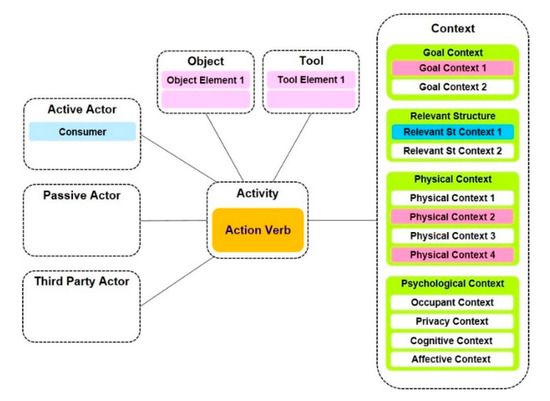
Figure 11.
Schema of CBAM where a relevant structure context element is controllable.
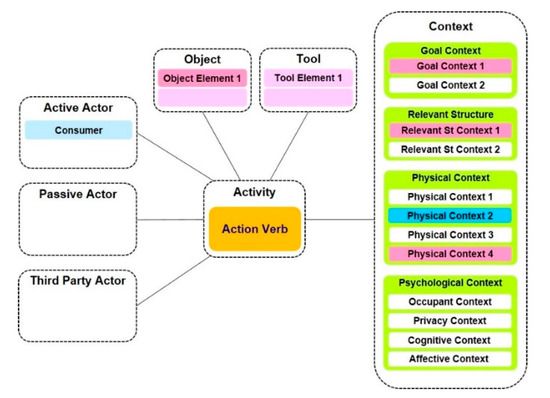
Figure 12.
Schema of CBAM where a physical context element is controllable.
5.2. Characterization of Personalized Customization Service Design Using Experience Evaluation
The personalized customization service design method is now characterized based on the visual reasoning model. Eight basic cognitive activities, and knowledge and schema, are interacting in the iterations of Seeing—Imagining—Drawing. This method is a structured method where customized services are synthesized, adapting to user-led specification and context. That is, Imagining is systematically supported. The personalized customization service design method is comprehensive, as it involves the user Seeing her experiences of Drawing during service deliveries in an accumulating manner so that specific user activities are evolutionarily transformed for customization exploiting the schema of CBAM. User experience evaluation is done using the specific schema of CESA. Note that user involvement in close interaction of the service system is critical in both devising and delivery of services where the schemas of CBAM and CESA continuously underlie the customization.
6. Discussions and Conclusions
6.1. Summary and Discussions on Contributions
Design thinking as a mindset and as a process for design and business innovation receives a lot of attention. Thus, concrete and structured methods to support design thinking and to foster design thinking abilities need to be devised. Design thinking has been recently explained [13] in the framework of visual thinking composed of iterative interaction of Seeing—Imagining—Drawing. The visual reasoning model developed to understand and support visual thinking describes the process with cognitive activities of perception, analysis, interpretation, generation, transformation, maintenance, internal and external representation, as well as knowledge and schema. This model is now receiving attention as an underlying cognitive model for design [25,26]. The visual reasoning model could serve as a framework to devise structured methods and tools for design thinking and to foster design thinking abilities.
Designers would perceive, analyze, and interpret the problem and the user issues. Designers then generate a new solution or transform an existing solution that is to be represented so that evaluations can be conducted. This paper addressed the role and contribution of one of the key constituents of the visual reasoning model, schema, in structured design methods. Schema support the organization of information in design reasoning. Such schema should support generation and transformation, allow representation, or accommodate perception, analysis, and interpretation. The research problem of the paper was to identify such schema for service design reasoning.
Service design seeks to realize values through human activities. The objects of designing in service design are typically human activities, and design solutions involve human activities. Thus, representation of activities would constitute schema in service design reasoning, addressing the underlying model with which design solutions are dealt. In this paper, the context-based activity modeling (CBAM) has been demonstrated as schema in three specific imagining methods for service activities for product-service systems.
In the first method, described in Section 3, the schema of CBAM supported structured What If? method just as the underlying model of activities. In the second method in Section 4, the schema of CBAM worked together with another schema of HVM which related the activities represented by CBAM with values. In the third method in Section 5, the schema of CBAM was used in the customization method dealing with information given by CBAM as controllable and constraining elements, and in accumulating experience evaluation data in conjunction with another schema for the evaluation function. In these different ways, the schema of CBAM as an underlying model of human activities in service imagining has been properly demonstrated.
At the same time, the contribution of the visual reasoning model as a framework for systematic imagining methods has been identified as the model accommodates versatile interactions of the constituents of the visual reasoning model are addressed and characterized. Design methods and tools support challenging the move from analysis to synthesis in design. Models bridging the analysis and the synthesis [56] help the exploration of new ideas and possible solutions. Thus, the paper suggests the implication that many more structured systematic design methods could be devised with CBAM as the core schema for service design where human activities and experiences are the key object of designing.
6.2. Discussions on Future Research
From the framework perspective of the visual reasoning model, the roles of CBAM schema in relation with other constituents of the visual reasoning model are different in these three cases. Studying different interactive roles of CBAM schema from the visual reasoning framework could help in understanding how design thinkers conduct their design reasoning tasks using structured design methods. This is certainly a future research topic.
As a token for more potential contributions of CBAM as the key schema in service design methods, the notion of sustainability features is briefly sketched in this discussion section. To design PSS for a circular economy, a sustainability feature can be conceived based on CBAM. Products of the wide spectrum from clothes to consumer products to industrial components and machines would go through many reuse phases. Thus, the use activity can be modeled using CBAM. For sustainability, circulations of the “use of the object” activity for many different active actors and contexts are to be supported. That is, the activity elements of active actor, object, and context of the use activity are key in these circulations. The states of the object in its function, behavior, and structure evolve as well as experiences of use. As in the structured customization service design method in Section 5, the use activity information can be carried throughout circulations in digital forms where assessment information on design for sustainability perspectives can be associated with experience evaluations attached with physical context data available from various sensors monitoring states of the object. For example, if the object is remanufactured for reuse, the object’s structure would need to be changed considering relevant structures of the object in the context of new uses. While there are many more issues, including other supporting services such as remanufacture, maintenance, collection etc., that need to be addressed in designing PSS for a circular economy, the core of use activity in a sustainable manner throughout circulations could be supported with the CBAM schema.
Coming back to the discussions on the used clothes TakeIN, service activities would have to encompass use activities involving diverse experiences and engagements of use actors for better sustainability. Even the purchase activity can be encompassed so that the intent to donate the clothes at a later time can be declared at purchase so that the clothes information can be carried through donation and reuse activities. The clothes information produced by the manufacturer is stored and maintained through use and reuse unlike the current situation where collecting service providers need to re-generate clothes information once the clothes are donated. In this way, PSS operations on donation and reuse can be effectively supported. Additionally, clothes use culture and consumption behavior can be improved toward a sustainable material-social system for a circular economy.
Note that CBAM schema has been supported in service design tasks as a computer-based representation. Images of computer-based service blueprints with CBAM can be found in [30,38]. CBAM schema is, in other words, a formal modeling language for activities. Product lifecycle management (PLM) systems are now advancing to include service lifecycle management (SLM) [57]. As services are basically human activities [30], CBAM will play a key role in the computer-based representation of activities in SLM. Actor elements will be represented based on user modeling containing both static and dynamic information as well as assessment information [58]. Both objects and tools are of the class of PSSs which would include a spectrum from products to services as well as their combination. Goal contexts can be represented as activities and as values. Relevant structures are PSSs. Physical and psychological contexts would be represented as tuples with fields and their state values, as shown in Figure 7 and Figure 10. Note that physical context information can be acquired through various Internet of Things (IoT) sensors and smart devices and that psychological contexts can be associated with user inputs and experience evaluations using CESA as in the personalized customization method in Section 5. CBAM schema associates human activities and artifacts like products and services as used in the design for affordance method [47]. That is, CBAM describes human activities that are related with artifacts as their elements of objects, tools, and relevant structures. In this way, CBAM would form the core representation for combining PLM and SLM.
The visual reasoning model supported the development of learning support [59] and assessments of design reasoning competencies [17,18] in a comprehensive research project for design learning [60,61,62]. Now that design thinking has been described in the framework of visual thinking recently [13], the visual reasoning model would work as a framework to develop support methods and tools for identifying and fostering design thinking competencies. Future research would include investigation on how the CBAM schema could support design thinking competencies for different design thinkers and different design task contexts.
Author Contributions
All the authors contributed to all aspects of the research presented in this paper. Y.S.K. conceptualized and developed the context-based activity modeling (CBAM) and structured imagining methods using CBAM, led the design case, and wrote the manuscript. J.J. co-developed CBAM and structured imagining method using CBAM, conducted the design case, and reviewed and revised the manuscript. Y.H. developed the hierarchical value map and the context-specific experience sampling and analysis methods, developed the personalized customization service design method, and reviewed and revised the manuscript. S.J.H. developed the sustainability concept in the design case and the sustainability feature notion, and reviewed and revised the manuscript. All authors have read and agreed to the published version of the manuscript.
Funding
This research was partially supported by the Korean Ministry of Knowledge Economy under the project entitled the Product-Service Systems Design (10032146) conducted at Sungkyunkwan University and by the Korea Institute for Advancement of Technology under the project entitled the Product Development for Service Consideration (N0000876) conducted at the Korea National Cleaner Production Center and Sungkyunkwan University.
Conflicts of Interest
The authors declare no conflict of interest.
References
- Brown, T. Design thinking. Harv. Bus. Rev. 2008, 86, 84–92. [Google Scholar]
- Martin, R. The Design of Business: Why Design Thinking Is the Next Competitive Advantage; Harvard Business Press: Cambridge, MA, USA, 2009. [Google Scholar]
- Liedtka, J.; Ogilvie, T. Designing for Growth: A Design Thinking Tool Kit for Managers; Columbia University Press: New York, NY, USA, 2011. [Google Scholar]
- D School. Design Thinking Bootleg. 2018. Available online: https://dschool.stanford.edu/resources/design-thinking-bootleg (accessed on 9 January 2020).
- Dorst, K. The Core of ‘Design Thinking’ and its Application. Des. Stud. 2011, 32, 521–532. [Google Scholar] [CrossRef]
- Design Council. Eleven Lessons. A Study of the Design Process. 2005. Available online: www.designcouncil.org.uk (accessed on 19 November 2019).
- Dell’Era, C.; Magistretti, S.; Cautela, C.; Verganti, R.; Zurlo, F. Four Kinds of Design Thinking: From Ideating to Making, Engaging, and Criticizing. Creat. Innov. Manag. 2020, 29, 324–344. [Google Scholar] [CrossRef]
- Carlgren, L.; Rauth, I.; Elmquist, M. Framing Design Thinking: The Concept in Idea and Enactment. Creat. Innov. Manag. 2016, 25, 38–57. [Google Scholar] [CrossRef]
- Treffinger, D.J.; Isaksen, S.G.; Firestien, R.L. Theoretical Perspectives on Creative Learning and its Facilitation: An Overview. J. Creat. Behav. 1983, 17, 9–17. [Google Scholar] [CrossRef]
- Verganti, R.; Dell’Era, C.; Swan, K.S. Call for Papers-Design Thinking and Innovation Management. J. Prod. Innov. Manag. 2019. Available online: https://www.ingegneriagestionale.it/news/jpim-special-issue-design-thinking-and-innovation-management-matches-mismatches-and-future-avenues-submission-due-date-january-31st-2020/ (accessed on 9 January 2020).
- Cross, N. Engineering Design Methods–Strategies for Product Design; John Wiley and Sons, Ltd.: Chichester, UK, 2000. [Google Scholar]
- McKim, R.H. Experiences in Visual Thinking; Wadsworth Publishing: Belmont, CA, USA, 1972. [Google Scholar]
- Kim, Y.S.; Park, J.A. Service Design Thinking in the Framework of Visual Thinking. Des. J. submitted.
- Dorst, K.; Cross, N. Creativity in the Design Process: Co-Evolution of Problem–Solution. Des. Stud. 2001, 22, 425–437. [Google Scholar] [CrossRef]
- Goldschmidt, G. Design Thinking: A Method or a Gateway into Design Cognition? She Ji: J. Des. Econ. Innov. 2017, 3, 107–112. [Google Scholar] [CrossRef]
- Park, J.A.; Kim, Y.S. Visual Reasoning and Design Processes. In Proceedings of the 16th International Conference on Engineering Design, Paris, France, 28–31 July 2007. [Google Scholar]
- Park, J.A.; Kim, Y.S.; Cho, J. Visual Reasoning as a Critical Attribute in Design Creativity. In Proceedings of the International Design Research Symposium, Seoul, Korea, 10–11 November 2006. [Google Scholar]
- Park, J.A.; Yilmaz, S.; Kim, Y.S. Using Visual Reasoning Model in the Analysis of Sketching Process. In Proceedings of the Workshop Conference on Design Computing and Cognition, Atlanta, Georgia, 23–25 June 2008. [Google Scholar]
- Kosslyn, S.M. Mental imagery. In An Invitation to Cognitive Science: Visual Cognition, 2nd ed.; Kosslyn, S.M., Osherson, D.N., Eds.; MIT Press: Cambridge, MA, USA, 1995; pp. 267–296. [Google Scholar]
- Kavakli, M.; Gero, J.S. Sketching as Mental Imagery Processing. Des. Stud. 2001, 22, 47–365. [Google Scholar] [CrossRef]
- Schon, D.A. The Reflective Practitioner: How Professionals Think in Action; Basic Books: New York, NY, USA, 1983. [Google Scholar]
- Oxman, R. The Thinking Eye: Visual Re-cognition in Design Emergence. Des. Stud. 2002, 23, 135–164. [Google Scholar] [CrossRef]
- Tversky, B. What Does Drawing Reveal about Thinking? In Proceedings of the International Conference on Visual and Spatial Reasoning in Design, Cambridge, MA, USA, 15–17 June 1999. [Google Scholar]
- Lawson, B.; Dorst, K. Design Expertise; Architectural Press: Oxford, UK, 2009. [Google Scholar]
- Hay, L.; Duffy, A.; McTeague, C.; Pidgeon, L.; Vuletic, T.; Grealy, M. A systematic review of protocol studies on conceptual design cognition: Design as search and exploration. Des. Sci. 2017, 3, E10. [Google Scholar] [CrossRef]
- Nelson, J.; Menold, J. Opening the black box: Developing metrics to assess the cognitive processes of prototyping. Des. Stud. 2020, 70, 100964. [Google Scholar] [CrossRef]
- Kim, Y.S.; Lee, S.W. Service Design for Product-Service Systems Using Context-based Activity Modeling. In Proceedings of the International Association of Societies of Design Research Conference, Delft, The Netherlands, 31 October–4 November 2011. [Google Scholar]
- Vargo, S.L.; Lusch, R.F. Evolving to a New Dominant Logic for Marketing. J. Mark. 2004, 68, 1–17. [Google Scholar] [CrossRef]
- Pine, J.B., II; Gilmore, J.H. Welcome to the Experience Economy. Harv. Bus. Rev. 1998, 76, 97–105. [Google Scholar]
- Kotler, P.; Armstrong, G. Principles of Marketing, 8th ed.; Prentice Hall International: Upper Saddle River, NJ, USA; London, UK, 1999. [Google Scholar]
- Miettinen, S.; Koivisto, M. (Eds.) Designing Services with Innovative Methods; University of Art and Design Helsinki: Helsinki, Finland, 2009. [Google Scholar]
- Kimbell, L. Designing for Service as One Way of Designing Services. Int. J. Des. 2011, 5, 41–52. [Google Scholar]
- Zomerdijk, L.G.; Voss, C.A. Service Design for Experience-Centric Services. J. Serv. Res. 2010, 13, 67–82. [Google Scholar] [CrossRef]
- Patrício, L.; Fisk, R.P.; Cunha, J.F.; Constantine, L. Multilevel Service Design: From Customer Value Constellation to Service Experience Blueprint. J. Serv. Res. 2011, 14, 180–200. [Google Scholar] [CrossRef]
- Shostack, G.L. How to Design a Service. Eur. J. Mark. 1982, 16, 49–63. [Google Scholar] [CrossRef]
- Morelli, N. Developing New Product Service Systems (PSS): Methodologies and Operational Tools. J. Clean. Prod. 2006, 14, 1495–1501. [Google Scholar] [CrossRef]
- Patrício, L.; Fisk, R.P.; Cunha, J.F. Designing Multi-interface Service Experiences: The Service Experience Blueprint. J. Serv. Res. 2008, 10, 318–334. [Google Scholar] [CrossRef]
- Kim, Y.S.; Lee, S.W.; Lee, J.-H.; Han, D.M.; Lee, H.K. Design Support Tools for Product-Service Systems. In Proceedings of the 18th International Conference on Engineering Design, Copenhagen, Denmark, 15–18 August 2011. [Google Scholar]
- Stickdorn, M.; Schneider, J. This Is Service Design Thinking; BIS Publishers: Amsterdam, The Netherlands, 2010. [Google Scholar]
- Kim, Y.S.; Lee, S.W.; Jeong, H.; Kim, S.R.; Kim, J.H.; Noh, J.H.; Won, J.H. A Systematic Design Framework for Product-Service Systems and Its Implementation. In Proceedings of the International Conference on Service Science and Innovation, Kaohsiung, Taiwan, 29–31 May 2013. [Google Scholar]
- Cho, C.K.; Kim, Y.S.; Lee, W.J. Economical, Ecological and Experience Values for Product-Service Systems. In Proceedings of the 7th Design & Emotion Conference, Chicago, IL, USA, 4–7 October 2010. [Google Scholar]
- Goedkoop, M.J.; van Halen, C.J.G.; Te Riele, H.R.M.; Rommens, P.J.M. Product Service Systems, Ecological and Economic Basics; Dutch Ministries of Environment (VROM) and Economic Affairs (EZ): Hague, The Netherlands, 1999; Available online: https://www.researchgate.net/profile/Mark_Goedkoop/publication/293825785_Product_Service_systems_Ecological_and_Economic_Basics/links/56bc8a3008ae58832001e7f3.pdf (accessed on 31 October 2020).
- Tukker, A. Eight Types of Product-Service Systems: Eight Ways to Sustainability? Experiences from SusProNet. Bus. Strategy Environ. 2004, 13, 246–260. [Google Scholar] [CrossRef]
- Tan, A.R.; McAloone, T.C. Characteristics of Strategies in Product/Service-System Development. In Proceedings of the 9th International Design Conference, Dubrovnik, Croatia, 15–18 May 2006; pp. 1435–1442. [Google Scholar]
- Tukker, A. Product services for a resource-efficient and circular economy–A review. J. Clean. Prod. 2015, 97, 76–91. [Google Scholar] [CrossRef]
- Fernandes SD, C.; Pigosso DC, A.; McAloone, T.C.; Rozenfeld, H. Towards product-service system oriented to circular economy: A systematic review of value proposition design approaches. J. Clean. Prod. 2020, 257, 120507. [Google Scholar] [CrossRef]
- Kim, Y.S. A Methodology of Design for Affordances using Affordance Feature Repositories. AI Eng. Des. Anal. Manuf. 2015, 29, 307–323. [Google Scholar] [CrossRef]
- Kim, Y.S.; Suzuki, K.; Hong, S.J. Product Redesign for Service Considerations Using Affordances for Service Activities. Sustainability 2020, 12, 255. [Google Scholar] [CrossRef]
- Ceschin, F.; Gaziulusoy, I. Evolution of Design for Sustainability: From Product Design to Design for System Innovations and Transitions. Des. Stud. 2016, 47, 118–163. [Google Scholar] [CrossRef]
- Bhamra, T.; Lilley, D.; Tang, T. Design for Sustainable Behaviour: Using Products to Change Consumer Behaviour. Des. J. 2011, 14, 427–445. [Google Scholar] [CrossRef]
- Gentner, D.; Maravilla, F. Analogical Reasoning. In International Handbook of Thinking & Reasoning; Ball, L.J., Thompson, V.A., Eds.; Psychology Press: New York, NY, USA, 2018; pp. 186–203. [Google Scholar]
- Kim, Y.S.; Hong, Y.K.; Park, J.A. A Structured Systematic Imagining Method for Service Design Using Hierarchical Value Map. Des. Sci. submitted.
- Gutman, J. A means–end chain model based on consumer categorization processes. J. Mark. 1982, 46, 60–72. [Google Scholar] [CrossRef]
- Kim, Y.S.; Hong, Y.K. Systematic Method to Design Product-Service Systems Using Personalization Services based on Experience Evaluations. Int. J. Prod. Dev. 2019, 23, 353–385. [Google Scholar] [CrossRef]
- Kim, Y.S.; Hong, Y.K.; Kim, J.H.; Kim, Y.M. Context-Specific Experience Sampling for Experience Design Research. In Proceedings of the 18th International Conference on Engineering Design, Copenhagen, Denmark, 15–18 August 2011. [Google Scholar]
- Dubberly, H.; Evenson, S.; Robinson, D. The Analysis-Synthesis Bridge Model. Interactions 2008, 15, 57–61. [Google Scholar] [CrossRef]
- Wiesner, S.; Freitag, M.; Westphal, I.; Thoben, K.D. Interactions between Service and Product Lifecycle Management. Procedia CIRP 2015, 30, 36–41. [Google Scholar] [CrossRef]
- Chen, W.; Mizoguchi, R. Communication Content Ontology for Learner Model Agent in Multi-Agent Architecture. In Proceedings of the AIED Workshop on Ontologies for Intelligent Educational Systems, Le Mans, France, 18–19 July 1999; Available online: http://www.ei.sanken.osaka-u.ac.jp/aied99/a-papers/W-Chen.pdf (accessed on 9 January 2020).
- Wang, E.; Kim, Y.S. Intelligent Visual Reasoning Tutor. In Proceedings of the IEEE International Conference on Advanced Learning Technologies, Kaohsiung, Taiwan, 5–8 July 2005. [Google Scholar]
- Kim, Y.S.; Kang, B.G. Personal Characteristics and Design-Related Performances in a Creative Engineering Design Course. In Proceedings of the 6th Asian Design Conference, Tsukuba, Japan, 14–17 October 2003. [Google Scholar]
- Kim, Y.S.; Kim, M.H.; Jin, S.T. Cognitive Characteristics and Design Creativity: An Experimental Study. In Proceedings of the ASME Conference Design Theory and Methodology, Long Beach, Hong Kong, China, 24–28 September 2005. [Google Scholar]
- Kim, Y.S.; Lee, S.W.; Park, J.A.; Jeong, J.Y. Exercises for Cognitive Elements of Design Creativity. In Proceedings of the 17th International Conference on Engineering Design, Stanford, CA, USA, 24–27 August 2009. [Google Scholar]
Publisher’s Note: MDPI stays neutral with regard to jurisdictional claims in published maps and institutional affiliations. |
© 2020 by the authors. Licensee MDPI, Basel, Switzerland. This article is an open access article distributed under the terms and conditions of the Creative Commons Attribution (CC BY) license (http://creativecommons.org/licenses/by/4.0/).